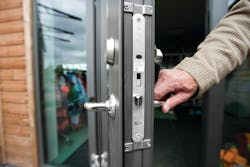When it comes to architectural hardware, electronics are probably not the first thing that springs to mind. But take a closer look – electronic hardware devices are in most of the facilities you interact with every day: airports, hospitals, malls, grocery stores, hotels, and more.
Electronic and electrified hardware is playing an increasingly significant role in builders hardware, especially when it comes to maintaining the delicate balance between security and accessibility in public spaces. It has proven useful in controlling access points while complying with government codes, preserving energy, and managing the flow of large groups of people.
The Builders Hardware Manufacturer’s Association (BHMA) certifies all types of builders hardware and over the decades has expanded its standards to include rigorous testing for emerging technology and the ever-growing roster of electronic hardware products. So what are they and where are they most common? And how are they tested?
Power-Operated Doors. Probably one of the most prevalent and familiar electronic builders hardware, power-operated doors are actually broken down into three categories:
- Revolving doors can accommodate a heavy flow of traffic while providing an air lock, contributing to regulating temperature and reducing energy costs. They can also be outfitted with card readers to control access.
- Automatic power doors are swinging, folding, or sliding power-operated doors that can be used to aid in accessibility. Because they are operated on full power, BHMA requires several safety requirements in order to prevent injury.
- Power assist doors are used mainly to comply with the Americans with Disabilities Act since these provide access to buildings by the controlled use of a power door. Typically, these are doors with marked buttons on the interior and exterior which need to be pushed to activate.
The first two types of power-operated doors have active control systems but activate automatically via censors. Power assist doors, however, require what BHMA refers to as a “knowing act” to prompt a response, such as a button near the door, and so it must meet specific limits in the speed of the door and the kinetic energy used to open it in order to be compliant.
Electric Strikes and Electrified Locks. To secure doors, electric strikes and electrified locks play an integral role in the security of many buildings, such as banks. For example, electric strikes are commonly found on the doors of ATM vestibules in order to prevent unauthorized access. When the proper credential is swiped (such as a bank card), it causes the frame itself to be retracted from the lock or latch and release the door without the need for manual lock operation.
Since electric strikes preceded much of the electronic builders hardware seen today, it was one of the very first standards for electronic hardware that BHMA specified. Standard A156.31 tests electric strikes and frame mounted actuators. To receive ANSI/BHMA certification, electric strikes – like all BHMA products – must pass a rigorous battery of tests, including opening and closing, strength, electric function, and finish durability assessments.
Electrified Keys. In situations where actual keys are necessary, electrified keys offer a variety of options. Electrical contact readers, insertion or swipe cards, electronic sensor keys, proximity cards (also known as “prox cards”) and keypads all provide a higher level of specificity in determining who can access a property than traditional keys inserted into mechanical locks. Additionally, some of these technologies can be updated in real time without possession of the physical key and can be equipped with information about who has accessed an area and when.
Delayed Egress Locks. When it comes to fulfilling egress requirements, delayed egress locks can be extremely helpful. These are electrified locks installed to control access over what is usually an emergency exit. For example, to be up to code, hotels are required to have a certain number of exits, but owners want control over who enters and exits from that door when there is not an emergency.
When the door to exit is pressed, a delayed egress lock will not allow the door to release for several seconds. Upon being opened, an alarm will sound to indicate that it has been activated. These doors usually have signs which indicate, “Press exit, alarm will sound.” Due to the obvious safety implications, these must be heavily tested and can delay egress no more than 15 seconds, depending on the specific application.
Delayed egress locks have come into popularity in large buildings and structures that require a high number of egress points. Warehouses use them to assist in the prevention of employee theft, while airports can utilize these locks to secure hundreds of access points. Even hospital wards, such as those for Alzheimer’s patients, have found delayed egress locks useful in alerting hospital staff to potentially hazardous situations.
Delayed egress locks are just one of the items on the extensive list of products categorized as part of electrified locking systems. Electrified locking systems are covered in ANSI/BHMA standard A156.25, which encompasses locking devices, input devices, controlling devices, and power supplies. Delayed egress locks are covered in ANSI/BHMA 156.24
Hinges. Finally, hinges are a surprising product often featuring electricity. Since hinges involve minimal movement, they have proven a useful storage vehicle to thread electrical wiring from the frame to the door.
Hinges were part of the very first BHMA standard ever written. A156.1 for Butts and Hinges had to be expanded over the years to include specifications and testing for electrified hinges. Testing involves a full cycle of the hinge 350,000 times, voltage measure, and wire functionality.
Expanding the Specifications
When BHMA began specifying standards in 1969, the focus was not initially on electrified builders hardware. Since then, standards testing has undergone constant updating to keep pace with evolving technology.
Covering electronics wasn’t just about creating new standards, but modifying old ones. One of the first standards for cylinders – A156.5 – had to be updated several times to encompass evolving electronic cylinders. And in the last several months alone, BHMA has amended three standards involving electrified hardware.
Electronic hardware devices have added components and therefore must be tested with additional features in mind – such as the safety and functionality of electrical equipment. They require additional electromechanical trials above and beyond the strictly mechanical testing for ordinary locking devices. Like all BHMA products, electronic architectural hardware must endure a battery of tests, including those for:
- door slams
- electrical functionality and durability
- environmental salt spray
- rain and dust
- overcurrent protection
- dielectric voltage
- inductive kickback
While electromagnetic locks, electric strikes, electrified keys, and other products can be some of the most difficult to specify, Builders Hardware Manufacturers Association ensures its technical committees are always up-to-date on products, using members as an important resource.
Learn more about electrified builders hardware and its testing by checking www.buildershardware.com or ordering a copy of the full list of ANSI/BHMA Standards.






